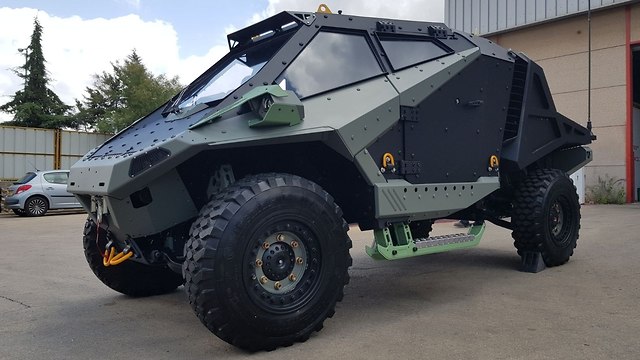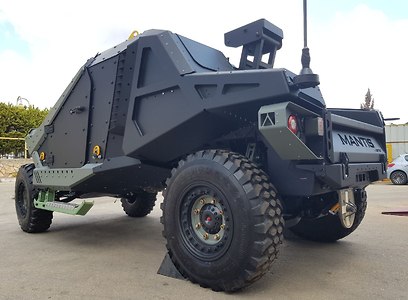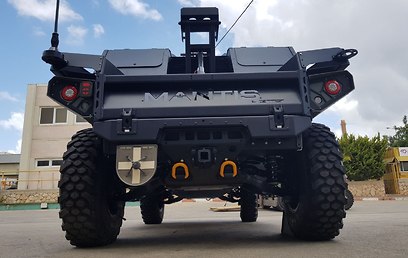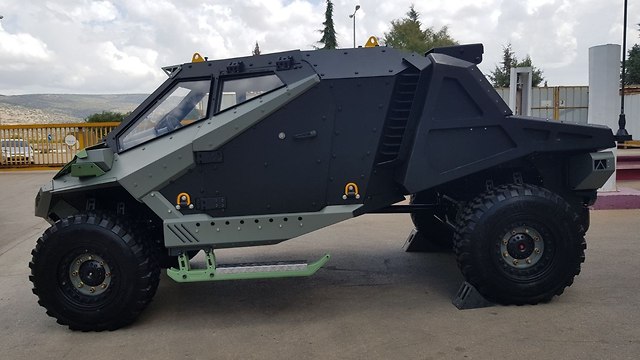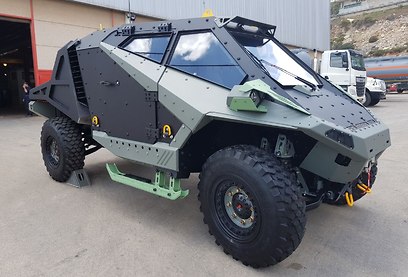
Carmor's Mantis APC
New Israeli APC to be unveiled at Paris trade show
Manufacturer of the new Mantis armored personnel carrier, which boasts an extraordinary appearance and state-of-the-art specifications, promises excellent navigability, high-end road performance and uncompromising shielding; Mantis to be unveiled at Eurosatory defense and security international exhibition in Paris next month.
A new Israeli armored personnel carrier—the Mantis, produced by the Israeli Carmor company—is expected to make its world début at the Eurosatory defense and security international exhibition, which will open in Paris next month.
Carmor Integrated Vehicle Solutions (previously known as Hatehof) CEO Eitan Zayit told Ynet that, "The Mantis brings Carmor into the category of armored vehicles under nine tons—the armored vehicle market's largest category—and provides unique, Israeli-developed solutions."
On the origins of the idea for the Mantis, Zayit said his company "decided to create a multitasking armored vehicle capable of navigating a variety of terrains and providing solutions for various theaters of war, which have been in flux over the last few years."
"We built a modular base that allows fitting for a multitude of activities such as reconnaissance, attack, intelligence, command, close assistance, relay and medicine. We therefore chose a sort of 'shielding capsule' that also serves as chassis, and allows to provide the required level of shielding while integrating a high degree of dynamism thanks to its relatively low weight," he explained.
The Mantis's relative advantage over other serially-produced vehicles, Zayit said, was brought to bear in a variety of ways. "Starting with navigability on technical terrain, through quick driving on pathways and ending with the maneuverability required in a dense urban environment," he boasted.
The Mantis's shielding, he added, was better than that of similarly-sized, serially-produced vehicles and is considered resistant to both land mines and improvised explosive devices (IEDs).
These features were achieved, the CEO expounded, using a proprietary "floating floor" that prevents distortion when the vehicle encounters a blast and collapsible chairs that better protect the soldiers driving the car.
Speaking of the Mantis's occupants, the passenger cabin is completely sealed and equipped with an air purification system, capable of meeting biological or chemical attacks.
The vehicle's driver is seated in the center with the engine located to the back, a configuration that is highly advantageous in many respects. The driver, for one, is afforded outstanding visibility in all directions thanks to the absence of a long engine cover—a familiar Achilles' heel in armored vehicles.
Shifting the engine to the back of the vehicle, meanwhile, provides a lower heat signature, which makes the vehicle stand out less when scanned by thermal detection devices, as well as better protection against gunfire that may take the vehicle out of commission if it scores a direct hit.
To the side and somewhat back of the driver are the vehicle's commander and systems operator, who enjoy not only a better field of vision but also quick, convenient access to the car's side doors. Behind them are two additional seats for soldiers.
Each occupant will enjoy increased "living space," Zayit vowed, with the cabin designed to allow soldiers to disembark especially quickly, but also to hold screens and various accompanying control systems.
The first Mantis model to be showcased at the Eurosatory trade show will resemble a pickup truck with a bed and a passenger cabin capable of housing five soldiers.
In the future, a truck with a larger bed and a three-soldier cabin will also be on offer, as will be a nine-soldier version and even an open buggy with partial shielding on its lower body.
'APCs don't have to be ugly'
On the vehicle's remarkable outward appearance, the Mantis's designer Amos Boaz remarked that, "One of the earliest things we had in mind when we started to plan the vehicle out was to create an element of surprise with a unique design that's different from the rest of the clunky, squared armored vehicles.""It was also a way of proving, while we were at it, that armored vehicles don't have to be ugly," he added, "by bringing in the world of aviation with a driver's position that resembles a cockpit on the one hand and sports cars on the other, thanks to a silhouette with a lot of mass sloping downwards in the front."
"I could go on, because the back part has a combination of different geometric shapes that break that heavy appearance to create the illusion of motion, and even a dirt bike due to the exposed wheels up front and the large space between them and the car's body above," he concluded.
The vehicle's planning was entrusted in the hands of Gili Hacohen, who was tasked with carrying out the same task for the Tomcar II, as well as some of the more classified vehicles currently in use by multiple armies' elite units.
"The biggest challenge was delivering designer Amos's first sketches to the serial production phase," he recalled, "and no less importantly to allow the integration between the different vehicle configurations and different propulsion systems. Everything here can be assembled, just like Lego."
On the Mantis's different configurations, Hacohen said that the prototypical vehicle was outfitted with a Cummins turbo-diesel engine with six cylinders and a 6.8 liter capacity, along with a 360 horsepower output.
He further explained that the engine will be hooked up to an automatic six-gear box by Ellison Electronics. The separate suspension arms to the front and back of the vehicle were manufactured by the Czech ATS company, which specializes in armored vehicles' propulsion systems.
The car will also be decked with enormous non-flat off-road tires from Continental, with an inflation and air pressure calibration system operated from within the cabin.
Hatehof was founded in 1947 and began operations as the manufacturer of armored vehicles used in supply routes to Jerusalem, which was then under Arab siege. It went through several transformations and also entered into production of tankers, fire trucks and riot control vehicles.
The company has been marketing under its most recent iteration—Carmor—a vehicle dubbed the "Wolf," an armored personnel carrier based on the Ford F550 that houses up to nine soldiers. Some 350 vehicles of the Wolf model are currently in use by the IDF.
The company is headquartered in the Ziporit Industrial Area in Nazareth Illit and employs some 100 people.










